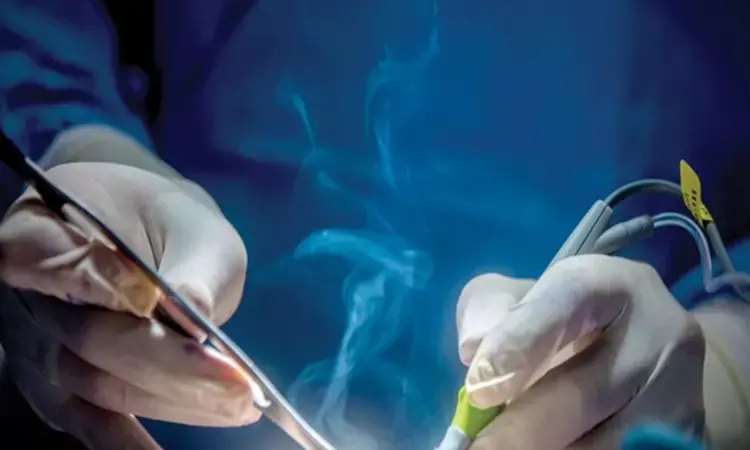- Home
- Medical news & Guidelines
- Anesthesiology
- Cardiology and CTVS
- Critical Care
- Dentistry
- Dermatology
- Diabetes and Endocrinology
- ENT
- Gastroenterology
- Medicine
- Nephrology
- Neurology
- Obstretics-Gynaecology
- Oncology
- Ophthalmology
- Orthopaedics
- Pediatrics-Neonatology
- Psychiatry
- Pulmonology
- Radiology
- Surgery
- Urology
- Laboratory Medicine
- Diet
- Nursing
- Paramedical
- Physiotherapy
- Health news
- Fact Check
- Bone Health Fact Check
- Brain Health Fact Check
- Cancer Related Fact Check
- Child Care Fact Check
- Dental and oral health fact check
- Diabetes and metabolic health fact check
- Diet and Nutrition Fact Check
- Eye and ENT Care Fact Check
- Fitness fact check
- Gut health fact check
- Heart health fact check
- Kidney health fact check
- Medical education fact check
- Men's health fact check
- Respiratory fact check
- Skin and hair care fact check
- Vaccine and Immunization fact check
- Women's health fact check
- AYUSH
- State News
- Andaman and Nicobar Islands
- Andhra Pradesh
- Arunachal Pradesh
- Assam
- Bihar
- Chandigarh
- Chattisgarh
- Dadra and Nagar Haveli
- Daman and Diu
- Delhi
- Goa
- Gujarat
- Haryana
- Himachal Pradesh
- Jammu & Kashmir
- Jharkhand
- Karnataka
- Kerala
- Ladakh
- Lakshadweep
- Madhya Pradesh
- Maharashtra
- Manipur
- Meghalaya
- Mizoram
- Nagaland
- Odisha
- Puducherry
- Punjab
- Rajasthan
- Sikkim
- Tamil Nadu
- Telangana
- Tripura
- Uttar Pradesh
- Uttrakhand
- West Bengal
- Medical Education
- Industry
Surgical smoke not a source of transmission of COVID-19 virus in health care workers: JAMA

Ontario, Canada: Electrocautery or surgical smoke is an unlikely source for the transmission of the SARS-CoV-2 virus for health care workers, according to a research letter published in the journal JAMA Surgery.
"Despite the high viral titers used, SARS-CoV-2 was not detectable in aerosol cautery plume generated from electrocautery under any of the study conditions. By mimicking surgery on a patient with a high SARS-CoV-2 load, there was a minimum of a 9 log reduction of viral RNA with any of the electrocautery methods," wrote the authors.
The SARS-CoV-2 virus has been detected in sputum, saliva, blood, bile, and feces and been shown to remain viable in aerosols for at least 3 hours. Several colleges have raised direct transmission to surgical staff from aerosolized virus in an electrocautery plume as a particular safety concern. Cautery performed in areas of high potential viral load could be risky to those in the operating room. Also, there is a possibility that sinonasal pathologies can mimic the symptom profile of COVID-19 and contribute to false-negative nasopharyngeal screening results, further increasing potential perioperative risk and exposure.
SARS-CoV-2 is more susceptible to higher temperatures due to the presence of a lipid bilayer. Inhalation of even small amounts of aerosolized virus appears sufficient to establish infection. However, tip temperatures of electrocautery range from 100 to 1200 °C, and as such, the temperature is potentially sufficient to inactivate SARS-CoV-2 in the plume.
Against the above background, Leigh J. Sowerby, University of Western Ontario, London, Ontario, Canada, and colleagues aimed to investigate the presence of live SARS-CoV-2 in electrocautery plumes after an institutional review board waiver and approval was received from Lawson Health Research Institute.
For this purpose, the researchers applied electrocautery at 25 W using 3 different methods for 1 minute on raw chicken breast with an added 4 mL of Dulbecco modified eagle medium (DMEM) or a DMEM:blood mixture containing 1 × 105.7 median tissue culture infectious dose (TCID50) per mL of SARS-CoV-2 which was similar to the viral load in pulmonary sputum of a patient with symptoms.
For positive control, approximately 0.3 mL of both viral media and blood with SARS-CoV-2 was aerosolized (without heat) into the chamber and collected in the same fashion. The gelatin filters were solubilized in phosphate-buffered saline and added in undiluted and 1:10 serial dilutions to VeroE6 cells to determine the TCID50 value of the vaporized virus following electrocautery.
Key findings of the study include:
- Using a cell titer glow measurement for replicating virus,6 we observed no virus recovered from any electrocautery performed.
- Collected aerosolized blood or media containing SARS-CoV-2 (approximately 0.3 mL) resulted in a recovery at least 3 or 4 base 10 logs higher than electrocautery or the negative control.
- The maximal theoretical recovery of SARS-CoV-2 on the gelatin filter was approximately 1 × 106.2 units (or 1 × 109.2 viral cytopathic effect units, from the cell titer glow measurement).
- Viral RNA was readily detected in the control aerosols of both fluids in the absence of cautery.
- The lack of SARS-CoV-2 was also confirmed by the lack of viral RNA on quantitative real-time polymerase chain reaction with undiluted vapor collected on the filter.
"This suggests that electrocautery smoke is an unlikely source of SARS-CoV-2 transmission for health care workers. This study is limited by the in vitro nature of the experiment, and collecting cautery plumes from airway surgery in patients with active SARS-CoV-2 would be definitive," wrote the authors.
"Future work investigating the plume associated with lower-temperature thermal surgery (such as coblation or carbon dioxide laser) and different tissue substrates is warranted."
Reference:
The study titled, "Assessing the Risk of SARS-CoV-2 Transmission via Surgical Electrocautery Plume," is published in the journal JAMA Surgery.
DOI: https://jamanetwork.com/journals/jamasurgery/fullarticle/2780434
Dr Kamal Kant Kohli-MBBS, DTCD- a chest specialist with more than 30 years of practice and a flair for writing clinical articles, Dr Kamal Kant Kohli joined Medical Dialogues as a Chief Editor of Medical News. Besides writing articles, as an editor, he proofreads and verifies all the medical content published on Medical Dialogues including those coming from journals, studies,medical conferences,guidelines etc. Email: drkohli@medicaldialogues.in. Contact no. 011-43720751


